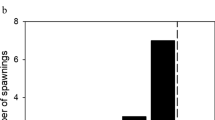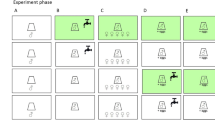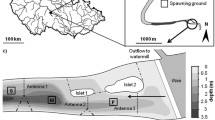Summary
Female Enallagma hageni oviposit underwater where they are inaccessible to males. I demonstrate that males guard submerged females rather than perch sites, and are behaviorally distinct from lone males at the water. In contrast to lone males, which always attempt to copulate with females presented to them, guarding males exhibit a conditional latency to remating which corresponds closely to the time required by females to oviposit a complete clutch of eggs. By ovipositing underwater, females decrease the risk that their eggs become exposed. Risks associated with submerged oviposition favor both mate guarding, and multiple, within-clutch matings by females. Both guarding mates and lone males ‘rescue’ females that float on the water surface as the result of improper resurfacing. Such behavior reduces the mortality risk to females from 0.06 to 0.02 per oviposition bout. By remating between bouts, females benefit from the additional vigilance of lone males, who rescue floating females 1.4 times as often as original mates. A second consequence of multiple mating is an increase in the selective advantage of vigilance by mates. Because receptive females become scarce by early afternoon, whereas male density remains high, a male has little (3%) chance of encountering a second receptive female that day. However, he incurs a 42% risk of losing fertilizations if he abandons a mate. For male E. hageni mate guarding functions in the context of both natural and sexual selection. It insures that a mate lives to lay a complete egg clutch in addition to protecting a male's sperm investment.
Similar content being viewed by others
References
Alcock J (1979) Multiple mating in Calopteryx maculata (Odonata: Calopterygidae) and the advantage of ron-contact guarding by males. J Nat Hist 13:439–446
Alcock J (1982) Post-copulatory mate guarding by males of the damselfly Hetaerina vulnerata Selys (Odonata: Calopterygidae). Anim Behay 30:99–107
Bick G, Bick J (1963) Behavior and population structure of the damselfly Enallagma civile (Hagen). Southwest Nat 6:57–84
Boggs CL, Gilbert LE (1979) Male contribution to egg production in butterflies: Evidence for transfer of nutrients at mating. Science 206:83–84
Borgia G (1981) Mate selection in the damselfly Scatophaga stercoraria: female choice in a male-controlled system. Anim Behav 29:71–80
Campanella PJ, Wolf LL (1974) Temporal leks as a mating system in a temperate zone dragonfly (Odonata: Anisoptera) I. Plathemis lydia (Drury). Behaviour 51:49–87
Emlen ST, Oring LW (1977) Ecology sexual selection, and the evolution of mating systems. Science 197:215–223
Fincke OM (1982) Lifetime mating success in a natural population of the damselfly Enallagma hageni (Walsh) (Odonata: Coenagrionidae). Behav Ecol Sociobiol 10:293–302
Fincke OM (1984a) Giant damselflies in a tropical forest: Reproductive biology of Megaloprepus coerulatus with notes on Mecistogaster (Odonata: Pseudostigmatidae). Ad Odonatol 2:13–27
Fincke OM (1984b) Sperm competition in a non-territorial damselfly (Odonata: Coenagrionidae): benefits of multiple mating to males and females. Behav Ecol Sociobiol 14:235–240
Fincke OM (1985) Alternative mate-finding tactics in a nonteritorial damselfly (Odonata: Coenagrionidae). Anim Behav 33:1124–1137
Fincke OM (1986a) Sources of variation in lifetime reproductive success in a non-territorial damselfly (Odonata: Coenagrionidae). In: Clutton-Brock T (ed) Reproductive Success. Uriversity of Chicago Press (in press)
Fincke OM (1986b) Female monogamy in the damselfly Ischnura verticalis. Odonatologica (in press)
Friedel T, Gillot C (1977) Contribution of male produced proteins to vitellogenesis in Melanoplus sanguinipes. J Insect Physiol 23:145–151
Gwynne DT (1984) Courtship feeding increases female reproductive success in bushcrickets. Nature 307:361–362
Harvey IF, Corbet PS (1985) Territorial behavior of larvae enhances mating success of male dragonflies. Anim Behav 33:561–565
Heymer A (1972) Comportements social et territorial des Calopterygidae (Odonata: Zygoptera). Ann Soc Entomol Fr 8:3–53
Jacobs ME (1955) Studies on territorialism and sexual selection in dragonflies. Ecology 36:566–586
McLain DK (1981) Interspecific interference competition and mate choice in the soldier beetle Chauliognathus pennsylvanicus. Behav Ecol Sociobiol 9:65–66
McVey ME (1986) The opportunity for sexual selection in a terriorial dragonfly Erythemis simplicicollis. In: Clutton-Brock T (ed) Reproductive Success. University of Chicago Press (in press)
Miller PL (1984) Alternative reproductive routines in a small fly, Puliciphora boringuenensis (Diptera: Phoridae). Ecol Entomol 9:293–302
Parker GA (1970) Sperm competition and its evolutionary consequences in the insects. Biol Rev 40:525–567
Robert PA (1958) Les libellules (Odonates). Delchaux et Niestle SA, Neuchatel
Sheruman KJ (1983) The adaptive significance of postcopulatory mate guarding in a dragonfly, Pachydiplax longipennis. Anim Behav 31:1107–1115
Sillén-Tullberg B (1981) Prolonged copulation: a male postcopulatory strategy in a promiscuous species Lygaeus equestris (Heteroptera: Lygaeidae). Behav Ecol Sociobiol 9:283–289
Smith RL (1979) Repeated copulation and sperm precedence: paternity assurance for a male brooding water bug. Science 205:1029–1031
Thornhill R (1980) Mate choice in Hylobittacus apicalis (Inseeta: Mecoptera) and its relation to some models of female choice. Evolution 34:519–538
Utzeri C, Falchetti E, Carchini G (1983) The reproductive behaviour in Coenagrion lindeni (Selys) in central Italy (Zygoptera: Coenagrionidae). Odonatologica 12:259–278
Waage JK (1979a) Adaptive significance of postcopulatory guarding of mates and nonmates by male Calopteryx maculata (Odonata). Behav Ecol Sociobiol 6:147–154
Waage JK (1979b) Dual function of the damselfly penis: Sperm removal and transfer. Science 203:916–918
Waage JK (1984) Sperm competition and the evolution of odonate mating systems. In: Smith RL (ed) Sperm competition and the evolution of animal mating systems. Academic Press, New York pp 251–290
Walker WF (1980) Sperm utilization strategies in nonsocial insects. Am Nat 115:780–799
Author information
Authors and Affiliations
Rights and permissions
About this article
Cite this article
Fincke, O.M. Underwater oviposition in a damselfly (Odonata: Coenagrionidae) favors male vigilance, and multiple mating by females. Behav Ecol Sociobiol 18, 405–412 (1986). https://doi.org/10.1007/BF00300514
Received:
Accepted:
Issue Date:
DOI: https://doi.org/10.1007/BF00300514




